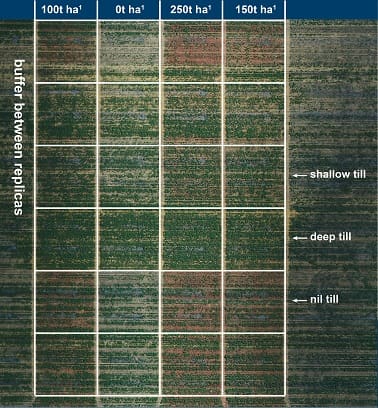SOIL water repellence on sandy soils can be significantly reduced by incorporating clay with deep tillage, boosting crop productivity and profitability.
Research by the Western Australian Department of Primary Industries and Regional Development (DPIRD), with support from the Grains Research and Development Corporation, found lupin yields increased by as much as 40 per cent when subsoil clay was incorporated via deep tillage.
DPIRD research officer Giacomo Betti said a large plot field experiment on deep sand at Moora found deep tillage, used with and without clay spreading, improved plant establishment on the water repellent soils.

An aerial view of a paddock showing the response of a lupin crop to a combination of claying and deep tillage treatments at Moora in 2017.
Mr Betti said while in the short time there was no significant difference in yields by incorporating claying, the long term benefits from using clay was still be determined.
“The results showed that deep soil mixing, in combination with clay or not, reduced water repellence severity and increased topsoil wettability compared with the control and shallow tillage,” he said.
“Subsoil clay added to the topsoil also reduced water repellence and improved plant establishment and crop productivity, however, negative results were recorded when the claying was poorly incorporated to a shallow depth or not incorporated at all.
“Analysis shows that increased evaporation and surface crusting from the poor incorporation of subsoil clay at rates of more than 150 tonnes per hectare, reduced crop establishment and yields.”
The experiment compared spreading subsoil with a clay content of 31pc at rates of 0, 100, 150 and 250t/ha, incorporated via shallow tillage using offset discs, deep tillage with a rotary spader or no tillage.
The crop of Barlock lupins was sown into a paddock that had been deep ripped prior to the trial and was cropped using a controlled traffic system in 2017, which was a below average rainfall season.
Early crop establishment and growth was measured using high definition aerial images taken by a drone, while a rainfall simulator was used to apply solutions of blue dye and water to help measure the effects of the treatments on topsoil wettability.
“The highest yields were achieved by a combination of deep tillage with 100 tonnes per hectare of clay, which produced 0.6 t/ha more than the control treatments,” Mr Betti said.
“No significant differences were found between the yields of treatments with nil and shallow tillage.”
Mr Betti said the results clearly showed that in dry seasons, such as 2017, reducing soil water repellence and increasing early crop establishment were key drivers to achieving higher yields.
“Preliminary results for the 2018 season continue to show the positive effects of deep soil mixing on yields of wheat and the negative effects of excess claying with little or no incorporation,” he said.
Source: DPIRD, agric.wa.gov.au

HAVE YOUR SAY